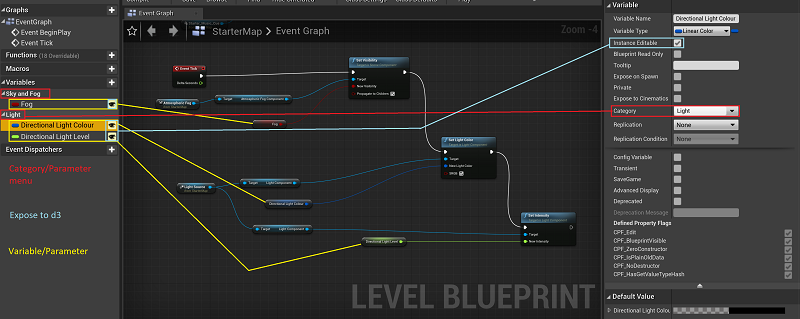The Unreal Engine plugin allows you to expose variables within the UE scene that can be used to control the parameters of the actors within the environment. These variables will be presented as parameters within the RenderStream Layer in Disguise software. Modifying the value of a parameter in turn changes the value of the corresponding variable within UE thus altering the parameter/s of the selected actor within the scene.
Steps for Exposing Parameters within a UE Scene
-
Creating and configuring a variable within the level Blueprint:
-
Click Blueprint in the Toolbar and select Open Level Blueprint.
-
Click the Add button next to Variables within the My Blueprint panel.
-
Name the variable according to the desired property (e.g. Fog Visibility).
-
Select the variable.
-
Set the Variable Type in the Details panel according to the desired property (e.g. visibility == boolean).
-
Enable Instance Editable.
-
Optionally, set Category to the name of the menu you wish the parameter to appear under in the RenderStream layer.
-
Optionally, configure ranges for the value.
-
Compile.
-
Set your desired Default Value for the variable in the Details panel.
-
-
Assigning an action to the variable:
-
Right-click and create an Event Tick action.
-
Return to the scene.
-
Select an Actor from the World Outliner panel (e.g. Atmospheric Fog).
-
Drag and drop the Actor into the Blueprint’s Event Graph.
-
Drag out from the blue pin (Static Mesh Actor Object Reference) on the Actor component and create any new Rendering Component Action (e.g. Set Visibility).
-
Drag out from the white pin (Exec) on the Event Tick action and connect it to the white pin (Exec) on the left-side of the Rendering Component Action.
-
Drag out from the New Component_Name pin (e.g. New Visibility) on the Rendering Component Action and create a Get Variable_Name action.
-
Compile and Save.
-
-
Save and close Unreal Engine.
-
Open the RenderStream layer in Disguise software and Start the workload.
-
Modify parameter value/s as part of your normal sequencing.

Warning: Remote Parameters attached to Event Tick are expensive and resource hungry and should only be used for frame syncronous keyframing of parameters. For general purpose manipulation of the scene, like adjusting lighting or placing objects - Unreal has workflows using the Remote Control API, or their Multi Editor products - which are far lower cost to the scene. This will help with performance optimisation on scenes..